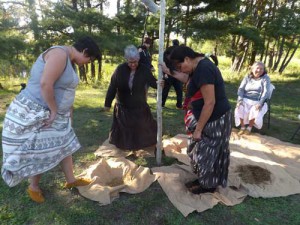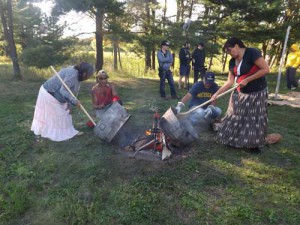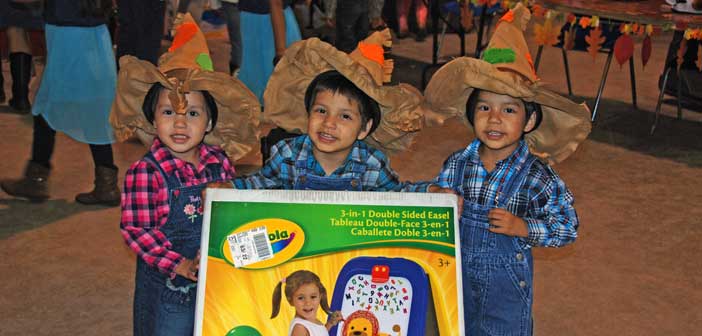WIKWEMIKONG—It has been five long years since the Wild Rice Restoration Program was established in Wikwemikong, but this past week a determined group of harvesters from the Wikwemikong community set out with paddle, canoe, push pole and hand-carved knockers to conduct the first harvest of the tasty northern grain.
Known to scientists by the Latin name zizania palustris and to much of the world as wild rice, Canadian rice or water oats, for the Anishinaabek the water plant is known as manoonin (harvest berry or more commonly translated as ‘good berry’) and was once a staple part of their yearly diet.
“Five years ago John Manitowabi and I decided to revitalize our wild rice beds,” explained Theodore Flamand, species at risk coordinator with the Wikwemikong Lands and Natural Resources Department. Program facilitator Mary Ellen Kitchikake and a group of hardy paddlers travelled to the Point Grondine area to plant some five hectares with wild rice seeds.
“We planted around five hectares with roughly 1,500 pounds of wild rice seed,” confirmed Mr. Flamand. Securing the seed was not an easy undertaking nor, as anyone who has purchased the pricey delicacy knows, was it cheap. “There is a fellow in Curve Lake who has been at it for about 25 years. He has been doing it commercially and has a big operation.” Buying the raw seed, and in bulk, is a fair bit less expensive than buying it in a grocery store because the wild rice is unprocessed, but it was definitely a determined investment—albeit not one made with strictly a commercial goal in mind.
“We want to bring it back to the community,” said Ms. Kitchikake. “Commercial exploitation was never the intent.”
The project was not for the weak of heart or impatient, as the last five years have certainly indicated, but things are definitely looking up.
“I think this last weekend was the number one indication that it was going to work,” said Ms. Kitchikake. “We didn’t harvest a lot, but we did go through the entire process and collected a harvest.”
There are a lot of reasons why the wild rice, common to the Great Lakes region, has all but disappeared from the local shallow lakes and ponds where it once was common.

“Water levels have changed and people moved away,” said program worker John Jones. Mr. Jones explained that one of the best ways to reseed the plant is actually to harvest it. While it might seem counterintuitive, it is in the spillage of seed as the plant is harvested that the plant expands in its beds. “Through the loss of the harvest the beds have shrunk and even disappeared altogether.”
Mr. Jones explained that the seeds could lay dormant in the lakebed mud for as much as a decade. “If you seed the year before, it might not come up,” said Mr. Jones.
A workshop group of eight set up base camp in the ‘rustic’ environs of the Killarney Bay Inn where the first few days were spent learning how to carve paddles, the knockers used to pound the seed heads while the stalks are bent over canoes to loosen the seeds and the birch bark pans used to winnow the wild rice from the chaff.
“When you look over the side of the canoe you can see the seeds spiraling down into the depths, just like those seeds that flutter down like little helicopters,” said Doreen Trudeau (Peltier) of Wikwemikong, who along with her sister Catherine Trudeau who was visiting from Folsom, California, joined the expedition. “It goes down to the bottom real fast,” agreed sister Catherine.
“Thank goodness for the lodge,” laughed Catherine. “It was really hard work and long days, so it was nice to have a comfortable bed and nice dinner to look forward to afterward. That was our salvation.” It was quite a change from the days of their youth.
“I don’t think anyone getting into the boat that first day knew what they were getting into,” laughed Mr. Flamand. “We worked them from daylight to dark.”
“It was elder abuse,” laughed Catherine, “we enjoyed every minute of it.”
The sisters recalled stories of wild rice harvests told by their father, the late William Trudeau, and both had fond memories of being taken on overnight berry picking sorties out to their band’s traditional harvesting grounds on nearby islands and boats returning with cranberries and other bounties of the bush, but neither had ever harvested wild rice before. “All of the family would go,” said Doreen. “We didn’t have very much in those days,” she said. “But we were very happy.”
“My only experience with wild rice before this was to buy it from the store and cook it,” laughed Doreen Trudeau. “I knew about wild rice harvests in the community because of my dad,” she said, quickly correcting herself to say “our dad.” Ms. Trudeau explained that coming from a large family, there were eight sisters, the children were admonished to never use the term “my” when referring to their parents. “It was always to be ‘our’,” she said.
Doreen Trudeau said that she got involved in the project when she got a call from her daughter saying that they were looking for a group of elders to go on the trip. “I talked to my sisters who were visiting me from California,” she said. “Only Catherine wanted to go.” Ms. Trudeau noted that after hearing about the trip her other sister was regretting her decision to forgo the opportunity.
Both sisters described the deep feelings of spiritual connection they felt with the land and their ancestors through the experience of the workshop and said that they have gained a new and deep appreciation of the hard work involved in the daily lives of their ancestors.

“We spent the first day making the sticks to pound the rice,” explained Catherine. “Then we also made the birch bark bowls before we set out in the canoes on Sunday morning.”
Part of the process involved seasoning the galvanized tubs that would be used to process or parge the wild rice.
“The tubs are made of zinc and lead,” explained Mr. Jones. “There is an oxide on the surface that you don’t want contaminating the rice.” Back in the day, the harvesters would have used huge cast iron cauldrons and before that containers such as hollowed logs and stone impressions containing water heated with stones from a roaring fire.
Although most of the participants in the workshop came from the Wikwemikong community, there was one notable exception.
“There was this lady from France who came out to see what we were doing from the Inn,” recalled Ms. Trudeau. “She was just staying at the Killarney Bay Inn but she was really interested in what we were doing.” The seventy-five year-old French adventurer soon found herself ensconced in a canoe and headed out to the wild rice beds.
It may have been a lot of hard work and effort, but Mr. Flamand summed up the feelings of the 11 people who took part this year. “It was a privilege,” he said.
The Wild Rice Revitalization Program is ongoing and while this year the program and the harvest camp benefitted from donations from Kenjegewin Teg Educational Institute, the Wikwemikong Library, the Wikwemikong Heritage Organization and the Lands Office, anyone who wishes to assist the program with a donation can contact the Lands office in Wikwemikong.




